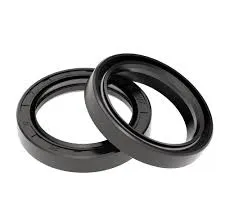10 月 . 06, 2024 07:01 Back to list
oil seal material
Understanding Oil Seal Materials A Comprehensive Guide
Oil seals play a crucial role in various mechanical systems, functioning primarily to prevent the leakage of lubricants and contaminants while ensuring the seamless operation of machinery. The performance and longevity of these seals rely heavily on the materials from which they are constructed. In this article, we will explore the most commonly used oil seal materials, their properties, and their applications.
1. Rubber
Rubber is the most widely used material for oil seals due to its excellent elasticity and resilience. Within the rubber family, nitrile rubber (NBR) is particularly prominent. NBR is known for its outstanding oil resistance, durability, and temperature tolerance, making it ideal for automotive applications and industrial machinery where exposure to oils and greases is frequent. Additionally, hydrogenated nitrile butadiene rubber (HNBR) offers even better heat and chemical resistance, making it suitable for applications in harsher environments.
2. Fluorocarbon
For applications that require superior chemical resistance, fluorocarbon elastomers such as Viton are preferred. These materials withstand aggressive chemicals and higher temperatures than standard rubber options. Fluorocarbon seals are especially beneficial in the aerospace industry and in conditions where high-performance seals are necessary to maintain integrity and reliability under extreme circumstances.
3. Polyurethane
Polyurethane is another material gaining popularity in oil seals. It possesses excellent abrasion resistance, tear strength, and flexibility, which makes it an ideal choice for demanding conditions. Polyurethane seals can operate efficiently in environments with varying temperatures and pressures, making them suitable for applications in hydraulics and heavy machinery.
oil seal material

4. Metal
In some cases, oil seals are made with a combination of materials, incorporating metal components for added structural integrity. Metal-oil seals offer robust protection against high-pressure applications and can endure significant mechanical stress. Common materials used in metal seals include stainless steel and aluminum, which resist corrosion and enhance durability.
5. Composite Materials
Recent advancements in technology have led to the development of composite materials that combine the beneficial properties of various substances. These composite oil seals can exhibit enhanced performance in terms of wear resistance, thermal stability, and chemical compatibility. This versatility makes them suitable for a wide range of applications across different industries, including automotive, aerospace, and manufacturing.
Selecting the Right Material
When choosing the appropriate oil seal material, several factors must be considered, including the operating temperature, type of fluid being sealed, environmental conditions, and mechanical stress. Understanding these parameters is crucial to ensure that the selected material can withstand the specific demands of the application.
Conclusion
In summary, the choice of oil seal material significantly impacts the functionality and life span of the seals in mechanical systems. From traditional rubber options like NBR and HNBR to specialized materials like fluorocarbon and polyurethane, each type presents unique benefits suited to various operational conditions. By understanding the properties and applications of these materials, engineers and designers can make informed decisions, ensuring reliability and efficiency in their mechanical systems. As technology advances, we can anticipate even more innovative materials that will continue to enhance the performance of oil seals across various industries.